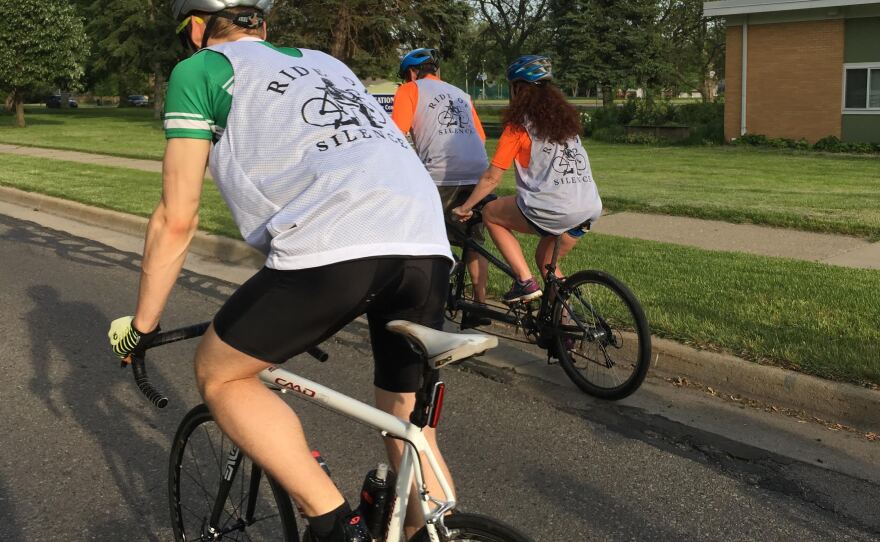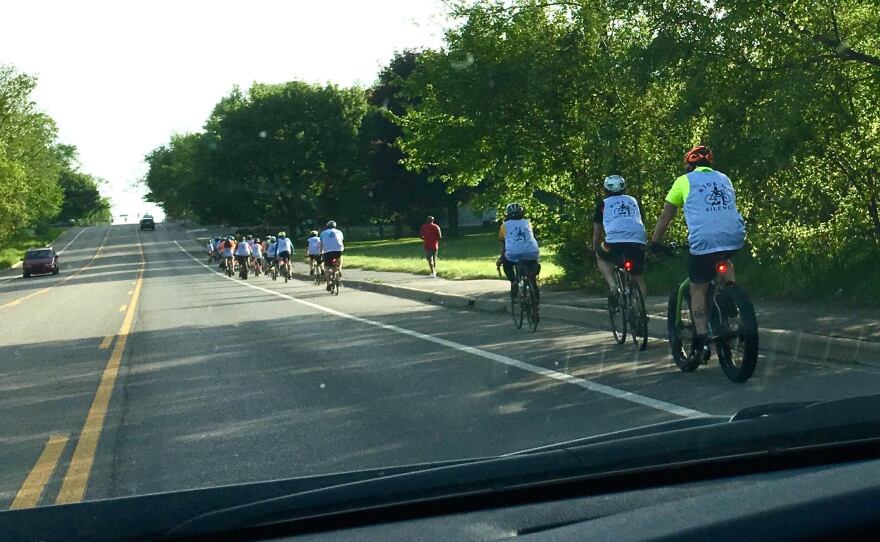More and more people are opting to cycle rather than drive for at least some of their transportation, whether for personal health, or for the health of the planet. But safety is an issue, and emotions run high. Conflicts occur over who has a right to the roadway. Should we encourage bicycles in the street, or should we try to separate bikes from cars? In this installment of WEMU’s Green Room series, Barbara Lucas explores varying perspectives.
David Fair (DF): This is 89-1 WEMU and I'm David Fair The Michigan State legislature is considering a statewide law mandating that drivers allow five-feet when passing cyclists. Another proposal under consideration would increase time spent in driver education on bicycle and pedestrian safety. Why are these measures even necessary? In this installment of WEMU’s Green Room series, Barbara Lucas talks to both drivers and cyclists, exploring: to whom does the road belong, and who must defer to whom?
Officer: Get your bike off the road. Do you have your identification?
BL: I’m watching dashcam video on Youtube of a 2015 interaction between a Michigan State Trooper and a bicyclist on a rural road in Washtenaw County.
Officer: All you did was pass somebody right after I told you single file and then you waved me on. Now, that to me gives me the impression that you want to be a smart aleck.
Cyclist: Officer, you completely misread my intentions.
BL: The cyclist had been riding two abreast with some friends, which the officer said was illegal. He said the cyclists should’ve been not only riding single file, but to the right of the white line, within the roadway shoulder.
Officer: …for interfering with traffic. It’s called impeding. You were in the roadway. You were to the left of the white line.
BL: He gave the cyclist a $200 ticket for impeding traffic. In this particular interaction, the cyclist remained respectful.
Cyclist: Please let me talk.
Officer: No, I don’t need to.
BL: Odette Petrini has a different story to tell.
Odette Petrini: Hostility… I mean it was really… there was so much hostility.
BL: We’re driving down Newport Road in Ann Arbor.
Petrini: You see the problem happened right up here.
BL: Hilly, windy, with no shoulder, Petrini felt it would be dangerous to pass two cyclists riding in the middle of the lane. So she lowered her daughter’s window, and asked them to move over.
Petrini: And they said the F-word and gave me the finger. Which was so unnecessary and so disheartening, because I'm not a foe, I'm a friend.
BL: Petrini is a cyclist herself. She’s unclear on the legalities of the situation.
Petrini: But isn't there something that says if there's a car behind you, you should form a single line? So the car can get around you?
BL: Regardless, she feels it would have been courteous of them to move over.
Petrini: Otherwise I would have had to follow them for miles. Going, you know, 25 or 20 miles an hour, which you know, what if… That's not really fair. What if I have to pick up my child from school or, you know, I have places to go. I'm going to work. It's just not fair, I think. It's saying that your time is not important but mine is. You know.
BL: I consult with James Walker, spokesperson for the National Motorists Association, who follows motorist laws closely.
James Walker: If a cyclist is riding at 12 miles an hour and there isn't room to get by, they are still legal. A cyclist in in most cases is allowed to use an entire lane. And if that's as fast as they can ride, so be it.
BL: But, there is a contradiction in the laws.
Walker: And Michigan law requires them to ride as close to the right hand side as is practical, unless there are big drains and other things in that last foot or so. The cyclists are required to try to give cars room to get by.
BL: But how far over? In the shoulder?
Trooper: Do you know what the law says?
Cyclist: I can ride as far right on the road as I deem necessary.
BL: It took two trials and the State Supreme Court to finally rule in favor of the cyclist in the video. The court said it IS legal to ride two abreast. And, an unimproved shoulder is NOT legally considered part of the road. But what about what we learned in drivers’ training, that cars can’t cross a double yellow line? Walker would like this detail specified.
Walker: That if the car driver needs to violate a single or double yellow line in order to go around the cyclist and give him the five foot room, that should be legal as long as it's safe, as long as there's no oncoming traffic, for that 50 feet that it takes to do it.
BL: But Ann Arbor City Administrator Howard Lazarus says debates about legal technicalities, whether concerning walkers in crosswalks or cyclists in roadways…
Howard Lazarus: …are arguments that are illogical and don't make sense in a community that sets itself up to be compassionate.
BL: He feels the core value of protecting life should be our guide. He hopes cyclists will be accepted as more of a feature on our roadways.
Lazarus: And that will mean, at times if you're driving your car, there are going to be points where it’s going to take you a little bit longer to get to where you want to go. And my recommendation is to relax and enjoy being in Ann Arbor, and just wait until you can pass safely and not get stressed over it.
BL: In cycle cities like Copenhagen or Amsterdam, there is strict adherence to this societal law: Yield to the more vulnerable. Cars to bikes, bikes to pedestrians. Jim Walker has driven the roads of Scandinavia and Europe.
Walker: Drivers are taught to be exceptionally careful, just as part of general societal training.
BL: How do we change a culture? Some feel driver training is a place to start.
Walker: Driver training in most of Europe is a serious business.
BL: Whereas in the United States, driver training…
Walker: …has been neglected grossly for the last twenty, thirty years at least?
BL: Although Walker acknowledges cyclists’ rights to be in the road, he thinks they should avoid high-traffic areas. Even if it means taking a short detour. Or riding on the sidewalk, which he notes IS legal, unless precluded by ordinance in posted areas.
Walker: Why wouldn’t you want to be as safe as you could? Why would you want to ride in the road to make a point that it's legal to put yourself in a position to be killed?
BL: Ideally, rather than fighting over who has rights to the roadway, he’d like to separate the uses. But better cycling infrastructure takes money, and in the meantime…
Officer: You can argue that with the judge.
BL: ... conflicts and collisions continue to occur.
'Ride of Silence' announcer: Welcome…
BL: I’m at the annual Ride of Silence in Ypsilanti.
Ride of Silence announcer: The basic message is for cyclists and motorists to get along and to share the road. And also to commemorate cyclists that have either been hit or killed on the road.
BL: Joining the ride is Stephanie Bowlang from PEAC, which stands for People for the Education of ALL Cyclists. This includes people with disabilities, many of whom can’t drive cars, whether to school or to jobs. Bowlang says cars squeezing past their students is a constant problem.
Stephanie Bowlang: So that's why they’re really advocating for the 5 foot law. That’s a big deal for our students. A lot of them won’t have drivers’ licenses. They are going to be riding bikes. And they are going to have to use the roads just like cars do. And we have the same rights.
BL: Do you think if the drivers knew the kids were disabled it would make a difference?
Bowlang: I’d like to think so but probably not. Honestly, they really don’t feel like cyclists should be on the road.
BL: Theoretically, our society does value protection of the vulnerable. But humans tend to fight over scarce resources. And both funding and roadway space are tight.
Walker: I think part of the tension is trying to give too much attention to a very small portion of commuters and riders. It's rare for cyclists to compose more than about 10 percent of commuting traffic, and in most cities it's a lot lower than that
BL: A case in point for Walker is the City of Ann Arbor’s Reimagine Washtenaw proposal.
Walker: That's insane to me on a major commuting artery that carries 44,000 vehicles a day and you're going to have a handful of cyclists get 26 percent of the paved surface.
BL: But Howard Lazarus says congestion is detracting from quality of life in Ann Arbor. He says along with building safe cycling infrastructure, we need more transit options.
Lazarus: And therefore encourage people to leave their cars either at home or at a Park and Ride. And once you do that the road becomes a lot more gentle.
BL: Can a society that prioritizes personal rights and saving time achieve a transportation system that is more gentle?
Lazarus: It's all about consideration for each other.
BL: In the “Green Room,” I’m Barbara Lucas, 89.1 WEMU News.
Resources:
National Motorists Association
“Bicyclist fights traffic obstruction ticket and wins,” MLive, March 2, 2016
“Cyclist obstructing traffic? Nope! Roll the videotape,” Bikelaw.com, Feb. 4, 2016









